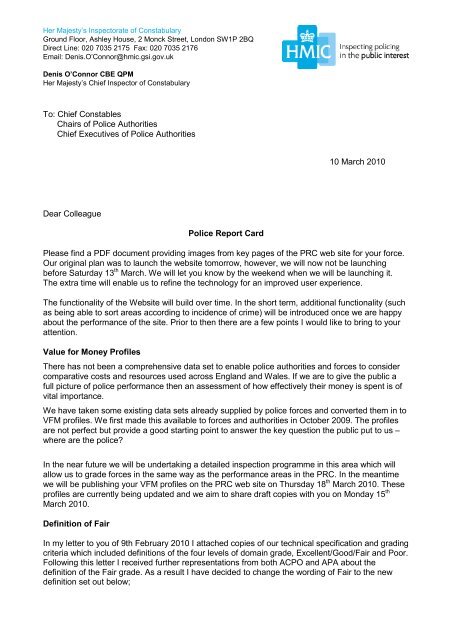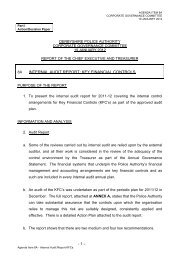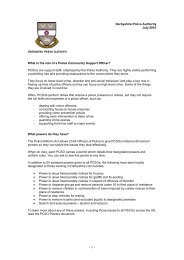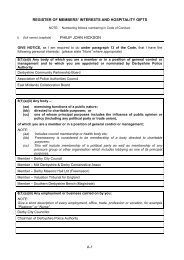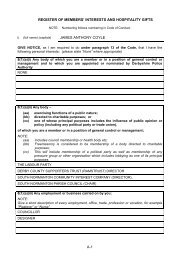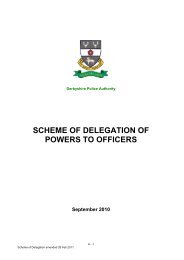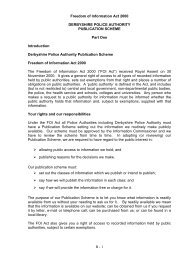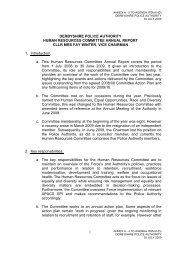HMIC Police Report Card - Derbyshire Police Authority
HMIC Police Report Card - Derbyshire Police Authority
HMIC Police Report Card - Derbyshire Police Authority
You also want an ePaper? Increase the reach of your titles
YUMPU automatically turns print PDFs into web optimized ePapers that Google loves.
Her Majesty’s Inspectorate of Constabulary<br />
Ground Floor, Ashley House, 2 Monck Street, London SW1P 2BQ<br />
Direct Line: 020 7035 2175 Fax: 020 7035 2176<br />
Email: Denis.O’Connor@hmic.gsi.gov.uk<br />
Denis O’Connor CBE QPM<br />
Her Majesty’s Chief Inspector of Constabulary<br />
To: Chief Constables<br />
Chairs of <strong>Police</strong> Authorities<br />
Chief Executives of <strong>Police</strong> Authorities<br />
10 March 2010<br />
Dear Colleague<br />
<strong>Police</strong> <strong>Report</strong> <strong>Card</strong><br />
Please find a PDF document providing images from key pages of the PRC web site for your force.<br />
Our original plan was to launch the website tomorrow, however, we will now not be launching<br />
before Saturday 13 th March. We will let you know by the weekend when we will be launching it.<br />
The extra time will enable us to refine the technology for an improved user experience.<br />
The functionality of the Website will build over time. In the short term, additional functionality (such<br />
as being able to sort areas according to incidence of crime) will be introduced once we are happy<br />
about the performance of the site. Prior to then there are a few points I would like to bring to your<br />
attention.<br />
Value for Money Profiles<br />
There has not been a comprehensive data set to enable police authorities and forces to consider<br />
comparative costs and resources used across England and Wales. If we are to give the public a<br />
full picture of police performance then an assessment of how effectively their money is spent is of<br />
vital importance.<br />
We have taken some existing data sets already supplied by police forces and converted them in to<br />
VFM profiles. We first made this available to forces and authorities in October 2009. The profiles<br />
are not perfect but provide a good starting point to answer the key question the public put to us –<br />
where are the police<br />
In the near future we will be undertaking a detailed inspection programme in this area which will<br />
allow us to grade forces in the same way as the performance areas in the PRC. In the meantime<br />
we will be publishing your VFM profiles on the PRC web site on Thursday 18 th March 2010. These<br />
profiles are currently being updated and we aim to share draft copies with you on Monday 15 th<br />
March 2010.<br />
Definition of Fair<br />
In my letter to you of 9th February 2010 I attached copies of our technical specification and grading<br />
criteria which included definitions of the four levels of domain grade, Excellent/Good/Fair and Poor.<br />
Following this letter I received further representations from both ACPO and APA about the<br />
definition of the Fair grade. As a result I have decided to change the wording of Fair to the new<br />
definition set out below;
“FAIR is awarded where performance is variable, but meets most of the requirements of the<br />
standard. Remedial action may be needed”<br />
Distinguishing the risk and performance areas of the PRC<br />
When we launch the PRC to the press and public I want to clarify that we will make it clear that the<br />
risk part of the web site refers to the force area and not specifically to force performance. Having<br />
said that it does not of course mean that there is no relationship between how well a force is doing<br />
and its crime rates, and in fact I am sure we would all agree that there must be. Members of the<br />
public may therefore ask you the legitimate question “why is crime relatively high where I live”.<br />
The quality of crime data<br />
I am disappointed that my auditors continue to find unacceptable discrepancies in the way that<br />
crime data is recorded by forces. This position is unfair on those of you who are producing high<br />
quality data. Our experience is that the more serious the crime, the more rigour the police forces<br />
scrutinise it. So consequently, the data on serious issues is stronger. We will sample crime data<br />
during the coming year, and will consider reducing grades for those forces that are continually<br />
submitting poor quality data.<br />
Antisocial behaviour (ASB)<br />
Members of the public on the receiving end of ASB find it hard to distinguish it from crime. And<br />
whilst we have ASB perception data, we do not have up-to-date current data on victims. To begin<br />
to address this we have commissioned Ipsos MORI to carry out research on this area. The results<br />
of this piece of work will be available on the PRC in the future. This is in addition to the ASB<br />
narratives for each force contained in the Local Crime and Policing domain.<br />
Solving crime<br />
We have used this title in the website because we have found that the public do not understand the<br />
term used by police professionals “sanction detections”. There is a debate about what should count<br />
as “detected” or “solved”.<br />
For example, some forces undertake community resolution to problems and they do not count at<br />
present as a solved crime. We think that this matter should be addressed so that there is clarity for<br />
the public over what is being achieved. We have agreed with ACPO and APA for this be prioritised<br />
in our PRC development work.<br />
Risk and Harm<br />
We have made a start on this with the “protection from serious harm” domain. It has only a limited<br />
set of data although we have supplemented it with our knowledge of the work police undertake that<br />
is largely unseen, for example, on tackling serious and organised crime.<br />
It is important that serious criminality gets serious treatment when looking at performance in the<br />
round, so we will be working hard with professionals and others in the sector to improve this<br />
dimension.<br />
Force context<br />
One of the core themes of our engagement with stake holders during the development of the<br />
<strong>Police</strong> <strong>Report</strong> <strong>Card</strong> was the desire to ensure that force performance is placed within an appropriate<br />
context. For example last year the police recorded 3.6 million calls from the public about antisocial<br />
behaviour last (compared with 4.6 million calls about crime). Of course this desire has to be<br />
balanced against the need to produce a concise and public facing web site. At a national level I
have provided some additional context in my overview which you will be able to find at:<br />
http://www.hmic.gov.uk/mypolice/pages/nationaloveriew.aspx<br />
Finally I would like to encourage you to use the report card as a driver for improving the service<br />
you provide to the public. Over the last few days we have spent much time discussing grades with<br />
forces and authorities; I hope that the release of these narrative will not only add context to those<br />
grades, but more importantly allow us all to move the debate forward into how we can develop the<br />
service to meet the growing expectations of the public in the most financially challenging<br />
environment of our generation.<br />
If you have any queries arising from this letter, please contact your <strong>HMIC</strong> regional office or the<br />
police report card programme manager - Superintendent David Harris - on 0207 035 2015 or at<br />
david.harris@hmic.gsi.gov.uk.<br />
Yours sincerely<br />
Denis O’Connor<br />
Her Majesty’s Chief Inspector of Constabulary


